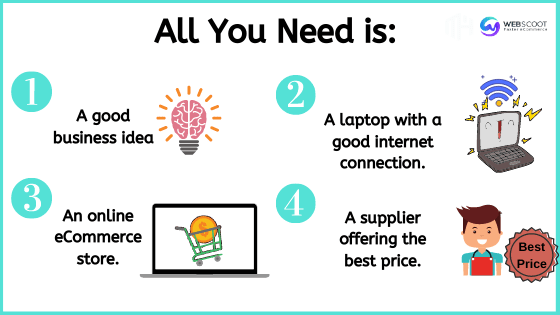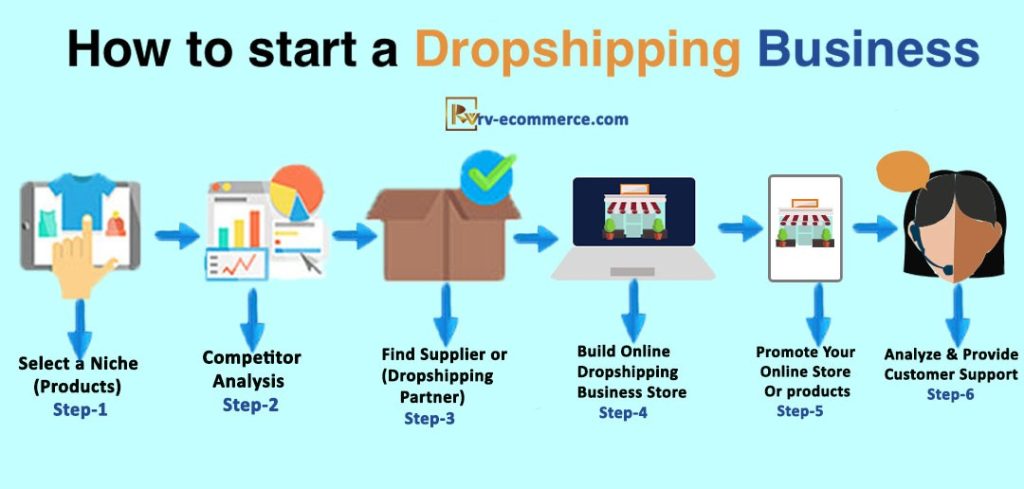To start a successful online drop shipping business, identify a profitable niche and select reliable suppliers. Create an engaging e-commerce website and market your products effectively.
Starting an online drop shipping business can be a lucrative venture with the right approach. First, research to identify a profitable niche that has demand but isn’t overly saturated. This helps you target a specific audience and stand out in the market.
Next, find reliable suppliers who offer quality products and dependable shipping. Your supplier’s reliability directly affects your business reputation. Then, create a user-friendly and visually appealing e-commerce website. Use SEO techniques to improve your site’s visibility in search engines. Finally, market your products through social media, email marketing, and paid advertising to reach a broader audience and drive sales.
Introduction To Drop Shipping
Starting an online drop shipping business can be a lucrative venture. This guide will help you understand the basics and benefits of drop shipping.
What Is Drop Shipping?
Drop shipping is a retail fulfillment method. The store does not keep products in stock. Instead, it transfers customer orders to a third party. The third party ships the products directly to the customer.
This means the seller does not handle the product directly. Drop shipping relies on a supply chain. The seller acts as a middleman between the customer and the supplier.
Benefits Of Drop Shipping
Drop shipping offers several benefits:
- Low Startup Costs: You do not need to invest in inventory.
- Easy to Start: Setting up a drop shipping business is simple.
- Flexible Location: You can run your business from anywhere.
- Wide Product Range: You can offer a variety of products without stocking them.
- Scalability: You can scale your business without worrying about inventory or warehousing.
Here’s a quick comparison of traditional retail and drop shipping:
| Aspect | Traditional Retail | Drop Shipping |
|---|---|---|
| Inventory | Requires investment | Not required |
| Storage | Needs storage space | No storage needed |
| Shipping | Handled by the seller | Handled by the supplier |
| Risk | Higher risk | Lower risk |
Choosing A Niche
Choosing a niche is the first step to starting a successful drop shipping business. It helps you focus on a specific market segment. This focus increases your chances of success. Below, we explore how to choose the perfect niche.
Market Research
Market research is vital for choosing a niche. It helps you understand what customers want. Here’s how to do effective market research:
- Analyze trends: Use tools like Google Trends to find popular topics.
- Study competitors: Check what other online stores are selling.
- Customer feedback: Read reviews to see what people like or dislike.
These steps will help you gather valuable insights into market demand.
Identifying Profitable Niches
Identifying profitable niches is crucial for success. Follow these guidelines:
- High demand: Choose products that many people need.
- Low competition: Find niches with fewer competitors.
- Good profit margins: Ensure your products offer good profits.
- Passion: Select a niche you are passionate about.
Here is a quick comparison table to help you:
| Criteria | High Demand | Low Competition | Profit Margins | Personal Interest |
|---|---|---|---|---|
| Example Product 1 | Yes | No | Medium | Yes |
| Example Product 2 | No | Yes | High | No |
Using this table format helps you compare different niches easily.
Finding Reliable Suppliers
Starting a successful drop shipping business begins with finding reliable suppliers. The right suppliers ensure product quality, timely shipping, and overall customer satisfaction. Here’s how you can find and evaluate reliable suppliers for your online drop shipping business.
Supplier Directories
Supplier directories are a great place to start your search. These directories list many verified suppliers and can save you time.
- Alibaba: This is a global marketplace with a vast range of products.
- SaleHoo: Known for its comprehensive supplier database and customer reviews.
- Worldwide Brands: Offers a wide range of certified wholesalers and drop shippers.
- Wholesale Central: Provides access to various suppliers and trade shows.
Evaluating Supplier Credibility
Evaluating the credibility of suppliers is crucial. Not all suppliers are reliable or trustworthy.
- Check Reviews: Look for reviews from other drop shippers.
- Test Orders: Place small test orders to check product quality.
- Communication: Reliable suppliers communicate well and answer queries promptly.
- Certifications: Look for industry certifications or awards.
- Business Age: Suppliers with longer business history are generally more reliable.
Use these steps to ensure your suppliers are credible and reliable. This helps maintain the trust of your customers and the success of your drop shipping business.

Credit: webscoot.io
Setting Up Your Online Store
Setting up your online store is a crucial step in your dropshipping journey. A well-organized store can attract customers and drive sales. This section will guide you through the process of selecting the right e-commerce platform and designing your store.
Selecting An E-commerce Platform
Choosing the right e-commerce platform is essential. It impacts your store’s functionality and user experience. There are several popular platforms available. Each platform has its own set of features and benefits.
- Shopify: Known for its ease of use and extensive app ecosystem.
- WooCommerce: A flexible option that integrates with WordPress.
- BigCommerce: Offers robust features and scalability for growing businesses.
Consider the following factors when selecting a platform:
- Ease of use: Ensure the platform is user-friendly.
- Customization: Check if you can easily customize your store.
- Payment options: Look for multiple payment gateways.
- Support: Ensure there is good customer support available.
Designing Your Store
Designing your store is more than just making it look good. It should be functional and easy to navigate. A clean design can enhance the user experience and boost sales.
Consider these tips to design an effective store:
- Choose a responsive theme: Ensure your store looks great on all devices.
- Use high-quality images: Clear images can attract and engage visitors.
- Organize products: Categorize your products for easy navigation.
- Optimize for SEO: Use keywords to improve search engine rankings.
Here is a table that summarizes key design elements:
| Design Element | Importance |
|---|---|
| Responsive Theme | High |
| High-Quality Images | High |
| Product Organization | Medium |
| SEO Optimization | High |
Follow these steps to create a store that is visually appealing and user-friendly. A well-designed store can greatly contribute to the success of your dropshipping business.
Creating A Strong Brand
Building a brand is vital for a successful drop shipping business. A strong brand helps you stand out from competitors. It attracts loyal customers and builds trust. Let’s explore how to create a strong brand.
Developing A Brand Identity
Your brand identity is how you present your business to the world. It includes your logo, colors, fonts, and messaging. These elements should be consistent across all platforms. Consistency helps customers recognize your brand easily.
Start by choosing colors that reflect your business values. Use fonts that are easy to read and match your brand personality. Design a logo that is simple yet memorable.
| Element | Tips |
|---|---|
| Logo | Keep it simple and relevant to your business. |
| Colors | Pick 2-3 colors that represent your brand. |
| Fonts | Use clear and readable fonts. |
Crafting A Unique Selling Proposition
Your Unique Selling Proposition (USP) sets you apart from competitors. It tells customers why they should choose you. A strong USP highlights the benefits of your products and services.
To craft a compelling USP, think about what makes your business special. Maybe you offer free shipping or have eco-friendly products. Make sure your USP is clear and concise.
- Identify what makes your products unique.
- Focus on the benefits for the customer.
- Keep it short and to the point.
A well-crafted USP can attract more customers and boost sales. Make sure to include it on your website, social media, and marketing materials.
Marketing Strategies
Starting a successful online drop shipping business requires effective marketing strategies. These strategies help attract, engage, and convert potential customers. By using these tactics, you can ensure long-term growth and profitability.
Social Media Marketing
Social media platforms are powerful tools for marketing your drop shipping business. They help you reach a large audience and build brand awareness.
- Facebook: Create a business page. Share engaging posts and ads.
- Instagram: Post high-quality images and stories. Use relevant hashtags.
- Twitter: Tweet regularly. Interact with your followers.
- Pinterest: Pin your products. Join group boards.
Use social media analytics to track your performance. Adjust your strategy based on the data.
Content Marketing
Content marketing involves creating and sharing valuable content. This attracts and retains your target audience.
- Blog Posts: Write informative articles about your products.
- Videos: Create tutorials and product demos.
- Infographics: Design visual content to explain complex ideas.
- Emails: Send newsletters with updates and promotions.
SEO is crucial for content marketing. Use keywords in your articles. This helps your content rank higher on search engines.
Here is a table summarizing key points for social media and content marketing:
| Marketing Strategy | Key Actions |
|---|---|
| Social Media Marketing | Post regularly, use hashtags, run ads |
| Content Marketing | Write blogs, create videos, design infographics |
Optimizing Your Store For Conversions
Optimizing your store for conversions is crucial for a successful drop shipping business. It involves refining various elements to increase the likelihood of visitors making a purchase. Below are some key areas to focus on for enhancing your store’s conversion rate.
Seo Best Practices
Implementing SEO best practices is vital for driving organic traffic to your store. Start with thorough keyword research to identify terms your target audience searches for. Use these keywords naturally throughout your product descriptions, titles, and meta tags.
- Use descriptive and unique product titles.
- Write detailed and keyword-rich product descriptions.
- Optimize your images with alt text.
Ensure your website loads quickly. A fast website improves your search engine ranking and keeps visitors engaged. Use tools like Google PageSpeed Insights to check your site’s speed.
| SEO Element | Action |
|---|---|
| Keywords | Include in titles, descriptions, meta tags |
| Alt Text | Optimize images with descriptive text |
| Site Speed | Ensure quick loading times |
User Experience Enhancements
Improving the user experience (UX) of your store can significantly boost conversions. Start by ensuring your website has a clean and intuitive design. Visitors should find what they need quickly and easily.
- Use clear and concise navigation menus.
- Ensure your website is mobile-friendly.
- Provide high-quality images and detailed product information.
Build trust with your customers. Display customer reviews and ratings prominently. Offer multiple payment options to cater to different preferences. A smooth checkout process is essential. Minimize the steps required to complete a purchase.
Lastly, provide excellent customer support. Offer live chat options and ensure your contact information is easy to find. A responsive customer service team can quickly address any issues, enhancing the overall shopping experience.

Credit: digitalnomads.world
Managing Orders And Customer Service
Managing orders and customer service is crucial for a successful dropshipping business. Efficient order fulfillment and excellent customer service can set you apart. Let’s break it down into two main aspects: Order Fulfillment Process and Handling Customer Inquiries.
Order Fulfillment Process
The order fulfillment process begins when a customer places an order. Here’s a simple step-by-step guide to help you manage it:
- Receive Order: Your store receives the order and payment.
- Send Order to Supplier: Forward the order details to your supplier.
- Supplier Processes Order: The supplier prepares the product for shipment.
- Shipping: The supplier ships the product directly to the customer.
- Tracking: Provide the customer with a tracking number.
Using automation tools can help streamline this process. Consider using software like Oberlo or Dropified.
Handling Customer Inquiries
Excellent customer service involves quick and helpful responses. This builds trust and loyalty. Here are some tips:
- Be Prompt: Respond to inquiries within 24 hours.
- Be Clear: Use simple language to explain solutions.
- Be Polite: Always maintain a friendly tone.
- Provide Updates: Keep customers informed about their orders.
You can use customer service platforms like Zendesk or Freshdesk. These tools can help manage and track inquiries.
| Task | Tool |
|---|---|
| Order Automation | Oberlo, Dropified |
| Customer Service | Zendesk, Freshdesk |
By following these guidelines, you can ensure a smooth order fulfillment process and provide excellent customer service. This will help you build a reliable and successful dropshipping business.
Analyzing And Scaling Your Business
Starting an online drop shipping business is just the beginning. To ensure success, you must analyze your data and scale your operations effectively. By doing so, you can identify growth opportunities and stay ahead of the competition.
Monitoring Key Metrics
Tracking key metrics is essential. It helps you understand your business performance. Focus on metrics like:
- Conversion Rate: The percentage of visitors who make a purchase.
- Customer Acquisition Cost (CAC): The cost of acquiring a new customer.
- Average Order Value (AOV): The average amount spent per order.
- Customer Lifetime Value (CLV): The total revenue from a customer over time.
Use tools like Google Analytics to monitor these metrics. Regular analysis helps you make informed decisions. Identify areas that need improvement and optimize your strategies.
Growth Strategies
Scaling your business requires strategic planning. Consider these growth strategies:
- Expand Your Product Range: Introduce new products to attract more customers.
- Optimize Your Website: Ensure your site is user-friendly and mobile-optimized.
- Leverage Social Media: Use platforms like Facebook and Instagram for marketing.
- Invest in SEO: Improve your search engine rankings to drive organic traffic.
- Offer Promotions: Provide discounts and special offers to increase sales.
By implementing these strategies, you can reach a larger audience. Always test different approaches and measure their impact. Adapt your strategies based on what works best for your business.

Credit: www.webcreta.com
Common Pitfalls And Solutions
Starting an online drop shipping business can be rewarding. But it’s important to know common pitfalls and how to solve them. This section will help you avoid mistakes and find solutions.
Avoiding Common Mistakes
Many new drop shippers make the same mistakes. Here are some to avoid:
- Choosing the wrong products
- Ignoring competition
- Poor supplier management
- Overlooking customer service
Choosing the wrong products can hurt your business. Pick products that have high demand and low competition. Use tools like Google Trends to see what people want.
Ignoring competition leads to failure. Study your competitors. Know their strengths and weaknesses.
Poor supplier management causes delays and unhappy customers. Always check your suppliers. Make sure they are reliable.
Overlooking customer service drives customers away. Always respond quickly to customer questions. Offer returns and refunds if needed.
Troubleshooting Tips
Problems will happen. Here are some tips to solve them:
- Track your orders
- Communicate with suppliers
- Handle returns efficiently
- Monitor inventory levels
Track your orders to avoid delays. Use tracking software to keep an eye on shipments.
Communicate with suppliers to solve issues quickly. Build strong relationships with them.
Handle returns efficiently to keep customers happy. Have a clear return policy and stick to it.
Monitor inventory levels to prevent stockouts. Use inventory management tools to keep track of stock.
Frequently Asked Questions
What Is Drop Shipping?
Drop shipping is a business model where you sell products online without holding inventory. Instead, you purchase items from a third party and ship them directly to customers.
How Do I Start Drop Shipping?
To start drop shipping, choose a niche, find reliable suppliers, set up an online store, and market your products effectively.
Do I Need A Website For Drop Shipping?
Yes, having a professional website is crucial for credibility and customer trust. It also helps in managing orders and showcasing products.
How Much Money Do I Need To Start?
Starting a drop shipping business can cost as little as a few hundred dollars. Initial expenses include website setup, marketing, and purchasing product samples.
Conclusion
Starting a successful online dropshipping business requires dedication and strategic planning. Focus on market research and choosing reliable suppliers. Implement effective marketing strategies to attract customers. Continuously monitor and optimize your store’s performance. With persistence and the right approach, your dropshipping venture can thrive and achieve long-term success.

